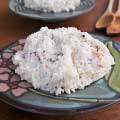
As Halloween approaches, bags and bags of candy line the shelves of every store I walk into. Most of the brightly colored packages holding sweet treats my little boy could never even taste—treats that look innocent enough, but because of allergies could send him to the ER in an instant or worse. I look over to him, now 7, as he walks past the confections and heads straight to the costumes, chatting away about how many superheroes he could be and what powers he’d have.
AUTISM OR FOOD ALLERGY?
Like many moms, I have a restless mind. It was no wonder that a week after my son’s second birthday when was diagnosed on the autism spectrum, I awoke frantically with a revelation my doctor once again thought was absurd. “You don’t understand,” I pleaded, “I know you think it is ridiculous, but you need to test him for everything.” When I was 16 I remember seeing this program on TV that said children who exhibited behavioral problems were actually reacting to food sensitivity. At that age, Ki’s appetite began to grow and so did the variety of food I was feeding him. So I began to fear that I could kill my son with a peanut butter sandwich.
After telling the doctor this, he responds with: “Neither you nor his dad have food allergies, so the chances of him being allergic should be slim.” The calmer he appeared the more anxiously I feared for Ki’s well being. His bedside manner did nothing to remove my fears. In the end he conceded, “but if you feel this strongly….”
Back then, after doing some research, I had found out that the CDC reported an 18% increase of food allergies since 1993. The CDC had also reported three times the normal increase in visits to ERs as a result of food allergies. Any concerned mother with this kind of data wasn’t going to take any chances, so I stuck to my guns and got the tests done immediately. No matter what the doctor thought of me, this was my child. I could never have dealt with any regrets, particularly since what I was about to learn was going to save my son’s life. Two days after the tests were administered the doctor’s office called. The results of the blood test revealed that my son was allergic to more than 15 foods! “What!? 15 foods. What am I going to feed him? What is he going to eat? He’s going to starve? What?!?” I said frantically to the doctor. I panicked. I felt that I had been slowly poisoning my child for the entirety of his short little life—could the results be right? That’s all I asked myself.
GET A SECOND OPINION
I converted my anxiety into action and began making calls. I had to get a second opinion. By Noon, we were in Manhattan in the office of Dr. Clifford Bassett, a renowned allergy specialist, who in fact had been on TV earlier that day talking on the subject of food allergies and children. During our visit he explained how blood tests often show false positive results. He then went on to do some tests on my baby boy. My husband and I used it as an opportunity to test ourselves as well, to see if we could determine if there was a genetic source to his allergies. Dr. Bassett’s tests used tiny needles to lightly prick the surface of the skin; each needle containing a potential allergen. A reaction to an allergy would cause the skin to become red or raised. The larger the reaction, the greater the allergy. Ki’s little arms reacted so badly that he looked like we had thrown him into a room filled with mosquitos. His tiny fingers scrambled to scratch the irritation as we rushed to rub an antihistamine to calm the reaction.
PROBLEM FOODS
According to the Food Allergy and Anaphylaxis Network, 90% of all food allergies come from one of eight sources. It turned out that Ki was allergic to three of the eight types of allergy causing food—soy, peanuts and tree nuts. The other five allergens people react to are wheat, eggs, cow’s milk, fish, and shellfish. Without these tests, my husband and I would have been oblivious to the fact that the soy milk we had been giving him was actually harming him. We had no idea how his body had reacted, but according to the exams, his soy allergy was acute. He had many other environmental allergies as well. We will never know whether the allergies are related to his autism, because his early intervention began as his diet changed. We do know that as soon as we stopped giving him soy, his development began to speed up.
LIFE WITH FOOD ALLERGIES
Having an allergy prone child makes you conscious of everything that involves food, even shopping takes longer because you have to make sure you read every ingredient in the food you buy. But there is an upside. It forced me to learn how to prepare healthier more wholesome foods. I learned to bake my own cookies and cakes and even to make ice cream; I wanted to ensure that his allergens would never be present and he could enjoy life’s simple pleasures without the fear of eating the wrong thing at the wrong time. He rarely eats out, and if he does, it usually involves lengthy conversations with restaurant staff about his situation.
So as the holiday where children begin to dream of Reese’s Pieces and Snickers bars that will be dropped in their bags approaches, my son who, because of his allergies, has never gotten used to candy, can only obsess about his costume. I breathe a sigh of relief, and I think about how I can help make his childhood special in other ways.
SUSPECT YOUR CHILD HAS ALLERGIES?
If you believe your child may have a food allergy or sensitivity there are many ways to be proactive. Keep a food diary and monitor your child’s response after eating certain foods. Some parents begin elimination diets where they remove certain foods from their child’s diet to see if their condition improves. Ultimately, the most important thing is to have a conversation with your pediatrician and perhaps even an allergy specialist. Symptoms vary from child to child when it comes to allergies and reactions to allergens. Some children may have rashes or breathing problems, others may exhibit hyperactivity or even darkened eye circles; be aware of anything that seems off and consult a doctor about any concerns.










